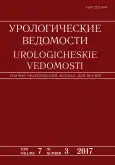Diagnosis and theraphy of urinary infections. What should always remember (clinical lecture). Part 1
- Authors: Borisov V.V.1
-
Affiliations:
- I.M. Sechenov First Moscow State Medical University
- Issue: Vol 7, No 3 (2017)
- Pages: 52-59
- Section: Articles
- URL: https://journals.rcsi.science/uroved/article/view/7102
- DOI: https://doi.org/10.17816/uroved7352-59
- ID: 7102
Cite item
Full Text
Abstract
The clinical lecture is devoted to the systematization of the knowledge of a wide range of physicians and urologists about the importance of the problem of uncomplicated urinary tract infections, their prevalence in our country and the world, the causes and frequency of occurrence in children and adults, diagnostic features based on clinical manifestations of the disease, laboratory data taking into account the formation of biofilms, the presence of sexually transmitted diseases. A special place is given to the problem of recurrences of cystitis due to the anatomical features of the female urethra, the need and the possibilities for their correction. An important place in the lecture is devoted to the role of general practitioners, district therapists, nephrologists, urologists, gynecologists in outpatient examination and treatment of these patients.
Full Text
##article.viewOnOriginalSite##About the authors
Vladimir V. Borisov
I.M. Sechenov First Moscow State Medical University
Author for correspondence.
Email: vvb56@yandex.ru
doctor of medical science, professor, Department of Internal, Occupational Diseases and Pulmonology
Russian Federation, 8-2, Trubetskaya street, Moscow, 119992References
- Guidelines on Urological Infections / M. Grabe, T.E. Bjerklund-Johansen, H. Botto, et al. European Association of Urology. 2011. 110 p.
- Guidelines on Urinary and Male Genital Tract Infections / K.G. Naber, B. Bergman, T.E. Bjerklund-Johansen, et al. European Association of Urology. 2001. 76 p.
- Naber KG. Antimicrobial treatment of bacterial prostatitis. European Urology. 2003;43(Suppl 2):23-26. doi: 10.1016/s1569-9056(02)00196-3.
- Naber KG, Cho Y-H, Matsumoto T, Schaeffer AJ. Immunoactive prophylaxis of recurrent urinary tract infections: a meta-analysis. International Journal of Antimicrobial Agents. 2009;33(2):111-119. doi: 10.1016/j.ijantimicag.2008.08.011.
- Hooton TM. Recurrent urinary tract infection in women. International Journal of Antimicrobial Agents. 2001;17(4):259-268. doi: 10.1016/s0924-8579(00)00350-2.
- Dwyer PL, O'Reilly M. Recurrent urinary tract infection in the female. Curr Opin Obstet Gynecol. 2002;14(5):537-543.
- Sivick KE, Mobley HL. Waging war against uropathogenic Escherichia coli: winning back the urinary tract [minireview]. Infection and Immunity. 2009;78(2):568-585. doi: 10.1128/iai.01000-09
- WHO Expert Committee on Specifications for Pharmaceutical Preparations: Forty-fourth report. WHO Technical Report Series No 957. Geneva: World Health Organization; 2010. 277 p.
- Палагин И.С., Сухорукова М.В., Дехнич А.В., и др. Современное состояние антибиотикорезистентности возбудителей внебольничных инфекций мочевых путей в России: результаты исследования ДАРМИС (2010–2011) // Клиническая микробиология и антимикробная химиотерапия. – 2012. – Т. 14. – № 4. – С. 280–302 [Palagin IS, Suhorukova MV, Dehnich AV, et al. Current State of Antibiotic Resistance of Pathogens Causing Community- Acquired Urinary Tract Infections in Russia: DARMIS Study (2010–2011). Klinicheskaja mikrobiologija i antimikrobnaja himioterapija. 2012;14(4):280-302 (In Russ.)]
- Франк У. Антибактериальная терапия в амбулаторно-поликлинической практике. – М.: ГЭОТАР- Медиа, 2010. – 256 с. [Frank U. Antibakterialnaja terapija v ambulatorno-poliklinicheskoj praktike. Moscow: GEOTAR-Media; 2010. 256 p. (In Russ.)]
Supplementary files







